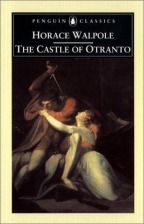The Castle of Otranto
Horace Walpole
Penguin Classics
UK Mass Market Paperback
ISBN 0-14-043767-3
Publication Date: 2001
Pages; Price: 101; $8.00
Date Reviewed: 03-05-03
Reviewed by: Katie Dean © 2003

REFERENCES
COLUMNS
|
|
|
The Castle of OtrantoHorace WalpolePenguin ClassicsUK Mass Market PaperbackISBN 0-14-043767-3Publication Date: 2001Pages; Price: 101; $8.00Date Reviewed: 03-05-03Reviewed by: Katie Dean © 2003 |
|
|
REFERENCES |
COLUMNS |
If you have previously been put off reading 'classic' literature purely by the length of most of these novels, "The Castle of Otranto" (Horace Walpole) might be a good place to start. At barely one hundred pages, this novel is essentially a mystery story set in a medieval castle haunted by ghosts and fantastic miracles. Originally published in 1764, it has barely been out of print since that time. Despite being written such a long time ago, the language is in no way antiquated, making the novel very readable. It can perhaps lay claim to being one of the first horror or fantasy novels published in England and is said to have inspired Bram Stoker (author of "Dracula").
Horace Walpole was the son of Sir Robert Walpole, Prime Minister of Great Britain during the eighteenth century. Horace also embarked upon a career in politics and was a keen amateur historian. He published a handful of other books during his lifetime, most of them factual works of history. As a young man, like many of his wealthy peers, Horace had been on the Grand Tour, an extended tour of Europe focusing upon the cultural and artistic heritage of the continent. Horace had spent some time in both France and Italy and it is likely that his stay in the latter country provided at least some of the inspiration for this novel. When he first published "The Castle of Otranto", Horace included a preface claiming that it was his translation of an Italian manuscript dating from medieval times. He went to some lengths to paint the story in this guise. However, the preface to the second edition admits Walpole to be the author, claiming that the story of the manuscript had been a cover in order that he could assess how well the public received the novel before admitting authorship.
In many ways, this novel could be set in any country. References to place names ensure that Italy is the scene, but the castle itself, upon which the action centres, does not appear necessarily Italian in style. In contrast, the era in which the novel is set is not in question. "The Castle of Otranto" is peopled with knights in shining armour coming to the rescue of damsels in distress and is clearly influenced by ideas of medieval chivalry. Walpole paints a thoroughly believable setting which is perfect for the mysterious events that take place.
"The Castle of Otranto" revolves around a curse that has been placed upon the family of Manfred, ruler of the principality of Otranto. The curse is slightly ill defined, but apparently threatens the end of Manfred's rule and destruction of his family. Manfred is a greedy man who plots and schemes to outwit this curse. He is clearly the villain of the novel and contrasts strongly with the three leading women, Hippolita his wife, Matilda his daughter and Isabella the intended wife of his son, all of whom are very pious and good. Accidentally thwarting Manfred's every move is the mysterious peasant Theodore who is painted more as a knight in shining armour than a simple peasant. Also important to the story are the minor characters in this novel, the household of Spanish servants. These are necessarily rather simple people, obviously believers in magic and ghosts and it is through their eyes that the various mysterious happenings are seen. This is a clever effect (Walpole claims he was inspired by Shakespeare in this literary detail) as it allows the reader to remain dubious about the veracity of various accounts of ghosts and miracles that are never effectively explained by Walpole. It is important that the main characters, especially Manfred, should believe in these events, but the reader is allowed to remain more sceptical.
The mystery essentially unfolds upon two levels, through the strange even occult events that symbolise the curse placed upon Manfred's family and through the appearance of two strangers who later turn out to be centrally bound up in this curse. Walpole carefully adds twists and turns throughout the novel. Just as one mystery appears to be unravelled or one problem solved, the actions of one of the characters create unforeseen complications. As Walpole himself claims in his preface, every incident in the novel is in some way crucial to the climax. As such this novel is very compelling, the reader can never be entirely sure what will happen on the next page. However, some of the more astute readers may perhaps guess the true identity of the mysterious strangers who appear at the castle gates. Perhaps the only criticism of this novel lies in the believability of the feelings of the characters. The reader feels more like an observer watching the changing moods of this family rather than sharing in the various characters' highs and lows.
"The Castle of Otranto" is definitely readable and compelling. In style it is typical of the rich language of many literary classics, but without the length that normally accompanies such great works. For anyone who enjoys a good mystery or perhaps likes a little horror or fantasy, it is definitely worth reading.